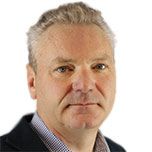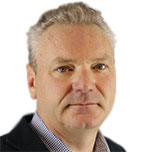Stablecoins: the future of money
This form of cryptocurrency might not yet be as well-known as bitcoin, but could prove more significant in the long term. Charlie Morris, founder of ByteTree.com, explains why.


When most investors think about cryptocurrencies, bitcoin is still almost certainly the first asset that springs to mind. And one thing most people associate with bitcoin is its volatility.
Yet one corner of the crypto market, which is becoming increasingly important and visible (if not always for the right reasons) aims to have precisely the opposite characteristic – stability.
From as early as 2013, banks were blocking law-abiding citizens from interacting with cryptocurrency exchanges. That made buying and selling bitcoin difficult. So the crypto industry simply took the banks out of the equation and replaced them with “stablecoins”. Put simply, a stablecoin is a dollar that lives on a blockchain.
MoneyWeek
Subscribe to MoneyWeek today and get your first six magazine issues absolutely FREE

Sign up to Money Morning
Don't miss the latest investment and personal finances news, market analysis, plus money-saving tips with our free twice-daily newsletter
Don't miss the latest investment and personal finances news, market analysis, plus money-saving tips with our free twice-daily newsletter
A $1 stablecoin is worth $1, it’s as simple as that. It can be traded easily for volatile assets such as bitcoin and ether. But it also offers crypto investors the opportunity to sit on the sidelines and hold a cash-like asset, one whose value is stable, at least in nominal terms (ie, ignoring inflation). Sometimes stablecoins even pay interest.
It’s the best example of unintended consequences I have ever seen. In public the banks would say how interesting they considered blockchain technology to be, backing numerous incubators and tech hubs. Yet behind the scenes they were devoting even more resources to blocking transactions to and from crypto.
Banks were eager to quash the crypto revolution. Instead, by necessitating the creation of stablecoins, they made crypto stronger. The stablecoin market is now worth $134bn and its existence has made crypto even more self-sufficient and less reliant on outsiders. It shows us how, in the years to come, it is the banks, not crypto, that will have to fight for survival.
Digital money
So what’s the big deal? It’s just a dollar on the blockchain. Don’t we already have digital money? Well, most people think they already have digital money because there’s an app on their phone that links to their bank, but they don’t. They just have a traditional bank deposit that can be administered electronically. The tech is better, but the money is the same. It sits on the bank’s balance sheet and, as we saw in 2008, that’s not always a good thing.
Stablecoins are a form of digital money that knocks out the bank entirely. Prior to stablecoins, the only way to transfer money was via an intermediary – a bank or a payment processor, such as Visa or PayPal. A stablecoin, however, is a digital form of cash, and it is more mobile than a bank deposit.
You don’t need a bank account, just a digital wallet, which can be downloaded for free. So it has the potential to find its way to any one of the world’s roughly 7.5 billion mobile phones. You can send that dollar around the world, swap it for crypto, swap it for another currency, or even buy other assets, goods and services. Best of all, it is a bearer asset, which means it’s yours, with no middleman in sight.
How stablecoins work
Most stablecoins (Dai – see the box – is an exception) are backed by an issuer who manages a pool of (preferably) low-risk assets, similar to a money-market fund. Those assets would include short-dated US Treasuries, corporate bonds, money-market instruments and cash. The issuer would benefit from any interest received, with an obligation to maintain the value of the assets so that the stablecoin is always worth $1.
The first successful stablecoin was issued by Tether (USDT). It has grown to $70bn in circulation.It is beset by controversy – the founders have “interesting” histories and some believe the asset backing is not quite what it seems. It has also had many a run-in with regulators and was recently fined $41m by the US Commodity Futures Trading Commission owing to “not having sufficient monetary reserves, consistently enough, to say the eponymous stablecoin was fully backed by US dollars”.
These questions over Tether have paved the way for new rivals. The main challenger is Circle (USDC), which has grown to $32bn over the past year. It has better relations with regulators and is more transparent. As a result, it is gaining market share. There are many other issuers in the crypto sector, such as Binance, Paxos and MakerDAO (see box).
More importantly, there are many outside the sector who would also like to be issuers, with the intention of making digital-bearer cash mainstream, such as Facebook’s project Diem, formerly known as Libra. The future of digital cash is an almighty land grab, which is already well under way. The future players may one day hold more deposits than the banks themselves. No wonder the regulators are paying attention.
What could possibly go wrong?
A private company issuing a stablecoin guarantees its digital dollars are fully backed by real dollars, but things can go wrong. Whether it be due to deception, incompetence, or financial meltdown, a stablecoin will never have the guarantees of physical cash, because that comes from the central bank. Then again, we also saw money-market funds “break the buck” in 2008: they could no longer guarantee that $1 invested was matched by $1 of assets. Given the size of these funds, their failure put the entire financial system at risk and so they were bailed out.
The speed of the growth in stablecoins is astronomical, with most of the growth coming over the past year. According to the Bank of England’s Jon Cunliffe, at $130bn, stablecoins account for just over 5% of all cryptoassets. That’s more than doubled since 2020, when they represented around 2% of the total. And while their use in crypto payment systems has so far been mainly for payments within crypto markets, “there are some signs that they are just beginning to be used by wholesale financial market players” and large corporations, notes Cunliffe.
Central banks and regulators have been watching this growth and perhaps fear it will get out of control. If instead central banks can launch their own central bank digital currencies (CBDC) then, the theory goes, there will be no need for stablecoins or other private-sector solutions. Yet that line of thinking is incorrect.
The People’s Bank of China has taken the lead in launching a digital yuan. This is ideal for snooping on the population’s spending habits and potentially even blocking them from certain purchases. It would also enable the central bank to introduce negative rates by reducing your balance over time, which would certainly encourage more spending over saving. Some also see CBDCs as a form of geopolitical influence. For example, a digital yuan could find its way to the four corners of the earth and facilitate transactions far from home. This presents an opportunity for the yuan to catch up with the US dollar.
But there are risks. How embarrassing would it be for a central bank to see its CBDC hacked or face an outage? Its credibility would never recover. By contrast, if a privately backed stablecoin (of sufficient scale) faced a problem, central banks could heroically come to the rescue – just as they did for the money-market funds during the financial crisis.
Changing how we interact with money
Currently, stablecoins don’t sit on their own blockchains, but on public blockchains, such as Ethereum, Stellar, Algorand, Solana, or Tron. For example, Circle (USDC) sits on Ethereum. So in order to send $100 of USDC you have to pay a fee in ether (ETH), the cryptocurrency associated with the Ethereum blockchain, which is paid to Ethereum’s miners for processing the transaction.
These fees vary with demand for blockchain space, and can swing wildly. A year ago, this fee would have been negligible. Last May, when crypto was all the rage, it would have been over $50. Now it is roughly $35. The trouble with this system is that you are paying for data rather than transaction value. That means a $1 transaction costs $35 to process, just as it would for $1m. But many more competing blockchains will join this list over the coming years. If $35 is too high – which it clearly is – then another solution will come along that offers lower fees (or there will be a “layer-2” solution – a subject for another day – that will transact “off chain”, more or less for free).
The underlying megatrend is that money is being digitised. Digital-bearer money, which bypasses the current banking system, will change how we interact with money. That could be a stablecoin, a social network, a payments company, a bank wanting to keep up with technology, or even a central bank that cares little for a free society. There are endless possibilities on how this could evolve, but stablecoins will only grow from here.
The leading stablecoins
Tether (USDT): a de-facto money market fund wrapped in a digital token that is pegged to the US dollar. It is closely linked to the crypto-exchange Bitfinex, which has helped Tether’s issuance of tokens grow to over $70bn. The integrity of the management and its asset backing have come under scrutiny.
Circle (USDC): USDC is regulated in the US and fully backed by US dollars, cash equivalents and US short-duration Treasuries with $32bn in circulation. As a result of regulatory scrutiny of Tether, USDC has ballooned, taking its market share from 14.3% of the stablecoin market to 24.1%. The firm behind Circle plans to list in New York via a special purpose acquisition company (Spac) called Concord Acquisition (NYSE: CND), with backing from asset managers Marshall Wace, Fidelity and Third Point, who have financed the deal with $415m. Circle is expected to be valued at $4.5bn and will trade with the ticker CRCL, although a date has yet to be announced.
Dai: an Ethereum-based stablecoin soft-pegged to the US dollar. MakerDAO enables users to generate Dai by depositing various other cryptocurrencies on the Maker Protocol and borrowing against their value at variable interest rates. Alternatively, Dai can be bought directly with fiat on digital asset exchanges.
Binance USD (BUSD): BUSD is another fiat-backed, regulated stablecoin pegged to the US dollar. BUSD exists on three blockchains: Binance Chain, Binance Smart Chain and Ethereum. For every purchase of one BUSD, one US dollar is held in reserve. Paxos, the project’s founder, releases monthly
audits of reserves.
Charlie Morris is the founder and chief investment officer of ByteTree (bytetree.com).
Get the latest financial news, insights and expert analysis from our award-winning MoneyWeek team, to help you understand what really matters when it comes to your finances.
-
 Pundits had a bad 2025 – here's what it means for investors
Pundits had a bad 2025 – here's what it means for investorsThe pundits came in for many shocks in 2025, says Max King. Here is what they should learn from them
-
 The MoneyWeek ETF portfolio – early 2026 update
The MoneyWeek ETF portfolio – early 2026 updateThe MoneyWeek ETF portfolio had a solid year in 2025 and looks well placed for what the next 12 months may bring
-
 Pundits had a bad 2025 – here's what it means for investors
Pundits had a bad 2025 – here's what it means for investorsThe pundits came in for many shocks in 2025, says Max King. Here is what they should learn from them
-
 The MoneyWeek ETF portfolio – early 2026 update
The MoneyWeek ETF portfolio – early 2026 updateThe MoneyWeek ETF portfolio had a solid year in 2025 and looks well placed for what the next 12 months may bring
-
 'Investors should brace for Trump’s great inflation'
'Investors should brace for Trump’s great inflation'Opinion Donald Trump's actions against Federal Reserve chair Jerome Powell will likely stoke rising prices. Investors should prepare for the worst, says Matthew Lynn
-
 The state of Iran’s collapsing economy – and why people are protesting
The state of Iran’s collapsing economy – and why people are protestingIran has long been mired in an economic crisis that is part of a wider systemic failure. Do the protests show a way out?
-
 The rise and fall of Nicolás Maduro, Venezuela's ruthless dictator
The rise and fall of Nicolás Maduro, Venezuela's ruthless dictatorNicolás Maduro is known for getting what he wants out of any situation. That might be a challenge now
-
 Polar Capital: a cheap, leveraged play on technology
Polar Capital: a cheap, leveraged play on technologyPolar Capital has carved out a niche in fund management and is reaping the benefits
-
 Vaccines inject billions into Big Pharma – how to profit from the sector
Vaccines inject billions into Big Pharma – how to profit from the sectorThe vaccines subsector received a big fillip from Covid, but its potential extends far beyond combating pandemics. Here's what it means for investors
-
 'Investors should keep putting their trust in investment trusts'
'Investors should keep putting their trust in investment trusts'Interview Peter Walls, manager of the Unicorn Mastertrust fund, analyses investment trusts in a conversation with Andrew Van Sickle
